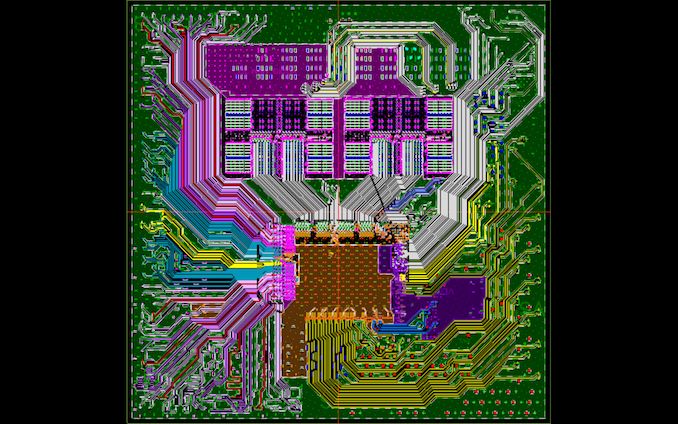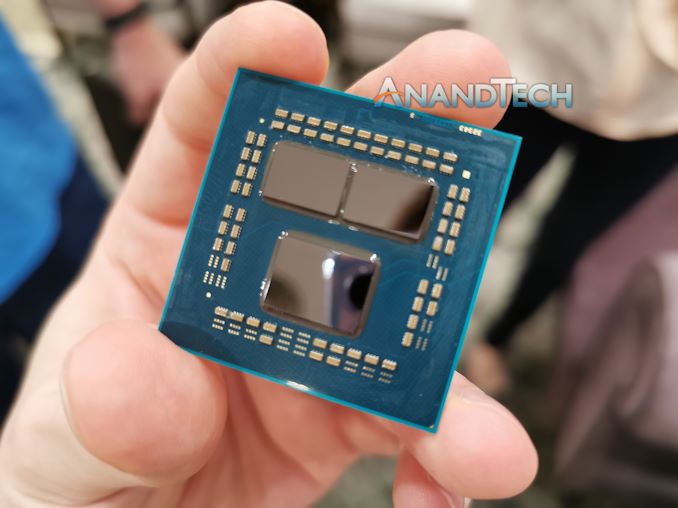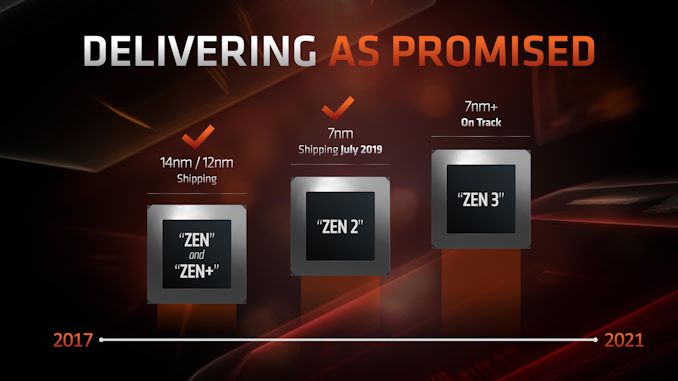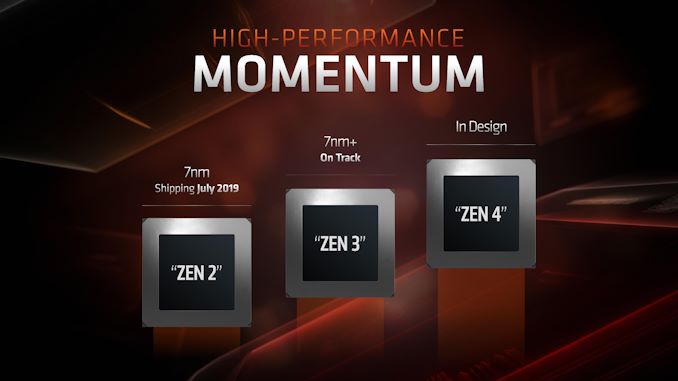AMD Zen 2 Microarchitecture Analysis: Ryzen 3000 and EPYC Rome
by Dr. Ian Cutress on June 10, 2019 7:22 PM EST- Posted in
- CPUs
- AMD
- Ryzen
- EPYC
- Infinity Fabric
- PCIe 4.0
- Zen 2
- Rome
- Ryzen 3000
- Ryzen 3rd Gen

Editor's Note: With Zen 2 set to launch tomorrow (7/7), here's our architecture analysis from last month for some timely background information.
We have been teased with AMD’s next generation processor products for over a year. The new chiplet design has been heralded as a significant breakthrough in driving performance and scalability, especially as it becomes increasingly difficult to create large silicon with high frequencies on smaller and smaller process nodes. AMD is expected to deploy its chiplet paradigm across its processor line, through Ryzen and EPYC, with those chiplets each having eight next-generation Zen 2 cores. Today AMD went into more detail about the Zen 2 core, providing justification for the +15% clock-for-clock performance increase over the previous generation that the company presented at Computex last week.
AMD’s Zen 2 Product Portfolio
The current products that AMD has announced that have Zen 2 cores include the Ryzen 3rd Generation consumer CPUs, known as the Ryzen 3000 family, and AMD’s next generation enterprise EPYC processor, known as Rome. As of today, AMD has announced explicit details of six consumer Ryzen 3000 processors, including core counts, frequencies, memory support, and power. Details about the server processor, aside from some peak values, are expected in due course over the next few months.
| AMD 'Matisse' Ryzen 3000 Series CPUs | |||||||||||
| AnandTech | Cores Threads |
Base Freq |
Boost Freq |
L2 Cache |
L3 Cache |
PCIe 4.0 |
DDR4 | TDP | Price (SEP) |
||
| Ryzen 9 | 3950X | 16C | 32T | 3.5 | 4.7 | 8 MB | 64 MB | 16+4+4 | 3200 | 105W | $749 |
| Ryzen 9 | 3900X | 12C | 24T | 3.8 | 4.6 | 6 MB | 64 MB | 16+4+4 | 3200 | 105W | $499 |
| Ryzen 7 | 3800X | 8C | 16T | 3.9 | 4.5 | 4 MB | 32 MB | 16+4+4 | 3200 | 105W | $399 |
| Ryzen 7 | 3700X | 8C | 16T | 3.6 | 4.4 | 4 MB | 32 MB | 16+4+4 | 3200 | 65W | $329 |
| Ryzen 5 | 3600X | 6C | 12T | 3.8 | 4.4 | 3 MB | 32 MB | 16+4+4 | 3200 | 95W | $249 |
| Ryzen 5 | 3600 | 6C | 12T | 3.6 | 4.2 | 3 MB | 32 MB | 16+4+4 | 3200 | 65W | $199 |
The Zen 2 design paradigm, compared to the first generation of Zen, has changed significantly. The new platform and core implementation is designed around small 8-core chiplets built on TSMC’s 7nm manufacturing process, and measure around 74-80 square millimeters. On these chiplets are two groups of four-cores arranged in a ‘core complex’, or CCX, which contains those four cores and a set of L3 cache – the L3 cache is doubled for Zen 2 over Zen 1.
Each full CPU, regardless of how many chiplets it has, is paired with a central IO die through Infinity Fabric links. The IO die acts as the central hub for all off-chip communications, as it houses all the PCIe lanes for the processor, as well as memory channels, and Infinity Fabric links to other chiplets or other CPUs. The IO die for the EPYC Rome processors is built on Global Foundries' 14nm process, however the consumer processor IO dies (which are smaller and contain fewer features) are built on the Global Foundries 12nm process.
The consumer processors, known as ‘Matisse’ or Ryzen 3rd Gen or Ryzen 3000-series, will be offered with up to two chiplets for sixteen cores. AMD is launching six versions of Matisse on July 7th, from six cores to sixteen cores. The six and eight-core processors have one chiplet, while above this the parts will have two chiplets, but in all cases the IO die is the same. This means that every Zen 2 based Ryzen 3000 processor will have access to 24 PCIe 4.0 lanes and dual channel memory. Based on the announcements today, the prices will range from $199 for the Ryzen 5 3600, up to $700+ for the sixteen core (we’re waiting on final confirmation of this price).
The EPYC Rome processors, built on these Zen 2 chiplets, will have up to eight of them, enabling a platform that can support up to 64 cores. As with the consumer processors, no chiplet can communicate directly with each other – each chiplet will only connect directly to the central IO die. That IO die houses links for eight memory channels, and up to 128 lanes of PCIe 4.0 connectivity.
AMD’s Roadmap
Before diving into the new product line, it is worth recapping where we currently sit in AMD’s planned roadmap.
In previous roadmaps, showcasing AMD’s movement from Zen to Zen 2 and Zen 3, the company has explained that this multi-year structure will showcase Zen in 2017, Zen 2 in 2019, and Zen 3 by 2021. The cadence isn’t exactly a year, as it has depended on AMD’s design and manufacturing abilities, as well as agreements with its partners in the foundries and the current market forces.
AMD has stated that its plan for Zen 2 was to always launch on 7nm, which ended up being TSMC’s 7nm (Global Foundries wasn’t going to be ready in time for 7nm, and ultimately pulled the plug). The next generation Zen 3 is expected to align with an updated 7nm process, and at this point AMD has not made any comment about a potential ‘Zen 2+’ design in the works, although at this point we do not expect to see one.
Beyond Zen 3, AMD has already stated that Zen 4 and Zen 5 are currently in various levels of their respective design stages, although the company has not committed to particular time frames or process node technologies. AMD has stated in the past that the paradigms of these platforms and processor designs are being set 3-5 years in advance, and the company states it has to make big bets every generation to ensure it can remain competitive.
For a small insight into Zen 4, in an interview with Forrest Norrod, SVP of AMD’s Enterprise, Embedded, and Semi-Custom group, at Computex, he exclusively revealed to AnandTech the code name of AMD’s Zen 4 EPYC processor: Genoa.
| AMD EPYC CPU Codenames | |||
| Gen | Year | Name | Cores |
| 1st | 2017 | Naples | 32 x Zen 1 |
| 2nd | 2019 | Rome | 64 x Zen 2 |
| 3rd | 2020 | Milan | ? x Zen 3 |
| 4th | ? | Genoa | ? x Zen 4 |
| 5th | ? | ? | ? x Zen 5 |
Forrest explained that the Zen 5 code name follows a similar pattern, but would not comment on the time frame for the Zen 4 product. Given that the Zen 3 design is expected mid-2020, that would put a Zen 4 product for late 2021/early 2022, if AMD follows its cadence. How this will play into AMD’s consumer roadmap plans is unclear at this point, and will depend on how AMD approaches its chiplet paradigm and any future adjustments to its packaging technology in order to enable further performance improvements.














216 Comments
View All Comments
Ratman6161 - Friday, June 14, 2019 - link
Better yet, why even bother talking about it? I read these architecture articles and find them interesting, but I'll spend my money based on real world performance.Notmyusualid - Sunday, July 7, 2019 - link
@ Ratman - aye, I give this all passing attention too. Hoping one day another 'Conroe' moment lands at our feet.RedGreenBlue - Tuesday, June 11, 2019 - link
The immediate value at these price points is the multithreading. Even ignoring the CPU cost, the motherboard costs of Zen 2 on AM4 can be substantially cheaper than the threadripper platform. Also, keep in mind what AMD did soon after the Zen 1000 series launch, and, I think, Zen 2 launch to a degree. They knocked down the prices pretty substantially. The initial pricing is for early adopters with less price sensitivity and who have been holding off upgrading as long as possible and are ready to spring for something. 3 months or so from launch these prices may be reduced officially, if not unofficially by 3rd parties.RedGreenBlue - Tuesday, June 11, 2019 - link
*Meant to say Z+ launch, not Zen 2.Spoelie - Wednesday, June 12, 2019 - link
To be fair, those price drops were also partially instigated by CPU launches from Intel - companies typically don't lower prices automatically, usually it is from competitive pressure or low sales.just4U - Thursday, June 13, 2019 - link
I don't believe that's true at all S. Pricing was already lower than the 8th gen Intels and the 9th while adding cores wasn't competing against the Ryzens any more than the older series..sing_electric - Friday, June 14, 2019 - link
That's true, but by most indications, if you want the "full" AM4 experience, you'll be paying more than you did previously because the 500-series motherboards will cost significantly more - I'm sure that TR boards will see an increase, too, but I think, proportionately, it might be smaller (because the cost increase for say, PCIe 4.0 is probably a fixed dollar amount, give or take).mode_13h - Tuesday, June 11, 2019 - link
Huh? There've been lots of Intel generations that did not generate those kinds of performance gains, and Intel has not introduced a newer product at a lower price point, since at least the Core i-series. So, I have no idea where you get this 10-15% perf per dollar figure.Irata - Tuesday, June 11, 2019 - link
So who does innovate in your humble opinion ?Looking at your posts, you seem to confuse / jumble quite a lot of things.
Example TSMC: So yes, they are giving AMD a better manufacturing that allows them to offer more transistors per area or lower power use at the same clock speed.
But better perf/ $ ? Not sure - that all depends on the price per good die, i.e. yields, price etc. all play a role and I assume you do not know any of this data.
Moores law - Alx already covered that...
As for the 16 core - what would the ideal price be for you ? $199 ? What do the alternatives cost (CPU + HSF and total platform cost).
If you want to look a price - yes, it did go up compared to the 2xxx series, but compared to the first Ryzen (2017), you do get quite a lot more than you did with the original Ryzen.
1800x 8C/16T 3,6 Ghz base / 4 Ghz boost for $499
3900x 12C/24T 3.8 Ghz base / 4,6 Ghz boost for $499
Now the 2700x was only $329, but its counterpart the 3700x has the same price, roughly the same frequency but a lower power consumption and supposedly better performance in just the range you mention.
Spunjji - Tuesday, June 11, 2019 - link
Nice comprehensive summary there!